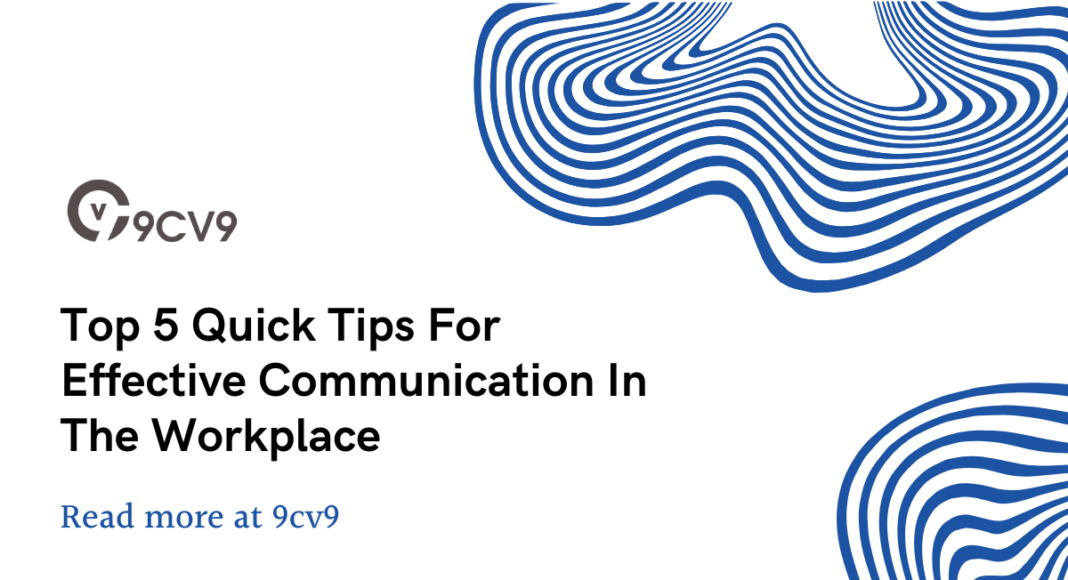Key Takeaways
- Clear and Concise Communication: Simplify messages to avoid misunderstandings and increase efficiency in workplace interactions.
- Active Listening: Enhance collaboration and trust by fully engaging with colleagues and responding thoughtfully to their input.
- Appropriate Communication Channels: Choose the right medium for each message to ensure effective delivery and maintain professional relationships.
In today’s fast-paced and increasingly digital work environment, effective communication is more vital than ever.
Whether you’re collaborating with colleagues across the office or connecting with remote team members halfway around the globe, the ability to convey ideas clearly and listen actively can make the difference between a thriving team and one that struggles to meet its goals.

Poor communication often leads to misunderstandings, errors, and inefficiencies that can erode trust, lower morale, and ultimately impact a company’s bottom line.
On the other hand, when communication is clear, concise, and thoughtful, it fosters a culture of collaboration, innovation, and mutual respect.
Communication in the workplace isn’t just about exchanging information; it’s about creating a shared understanding that drives effective teamwork and decision-making.
According to a study by McKinsey, teams that communicate effectively are 25% more productive than those that do not.
Moreover, the same study found that organizations with strong communication practices enjoy higher employee engagement and retention rates.
This highlights the fact that communication isn’t just a soft skill; it’s a business imperative that directly influences performance and success.
However, despite its importance, effective communication is often easier said than done.
The complexities of modern work environments—where diverse teams, cultural differences, and varying communication styles intersect—can make it challenging to ensure that everyone is on the same page.
This is why honing your communication skills is essential, regardless of your role or industry. Whether you’re a manager looking to lead your team more effectively or an employee aiming to enhance your professional relationships, mastering the art of communication can open doors to better collaboration, innovation, and overall job satisfaction.
In this blog, we’ll explore the top five quick tips for improving communication in the workplace.
These practical strategies are designed to help you communicate more effectively, whether you’re leading a meeting, giving feedback, or simply participating in a team discussion.
By implementing these tips, you’ll be better equipped to foster a more positive and productive work environment, where everyone’s voice is heard, and goals are met more efficiently.
Communication is the cornerstone of any successful organization, and by taking steps to improve how you communicate, you’re not only enhancing your own effectiveness but also contributing to the overall success of your team and company.
So, let’s dive into these tips and start building a stronger foundation for workplace communication today.
Before we venture further into this article, we would like to share who we are and what we do.
About 9cv9
9cv9 is a business tech startup based in Singapore and Asia, with a strong presence all over the world.
With over eight years of startup and business experience, and being highly involved in connecting with thousands of companies and startups, the 9cv9 team has listed some important learning points in this overview of the Top 5 Quick Tips For Effective Communication In The Workplace.
If your company needs recruitment and headhunting services to hire top-quality employees, you can use 9cv9 headhunting and recruitment services to hire top talents and candidates. Find out more here, or send over an email to [email protected].
Or just post 1 free job posting here at 9cv9 Hiring Portal in under 10 minutes.
Top 5 Quick Tips For Effective Communication In The Workplace
- Be Clear and Concise
- Active Listening
- Utilize Appropriate Communication Channels
- Provide Constructive Feedback
- Be Aware of Non-Verbal Communication
1. Be Clear and Concise

Effective communication in the workplace begins with clarity and conciseness.
When your message is clear and to the point, it minimizes the chances of misunderstandings and ensures that your audience comprehends your intent. Whether you’re sending an email, leading a meeting, or giving instructions, being clear and concise helps in delivering your message efficiently, saving time, and improving productivity.
Why Clarity Matters in Workplace Communication
- Prevents Misunderstandings:
- Unclear messages can lead to confusion, resulting in mistakes or misaligned expectations.
- Example: If a manager says, “We need this report soon,” without specifying a deadline, the employee may misunderstand and deliver it later than expected, causing delays.
- Enhances Efficiency:
- Clear communication ensures that tasks are understood correctly the first time, reducing the need for follow-up questions or corrections.
- Example: In a team meeting, if the project scope is clearly defined, team members can proceed without needing further clarification, speeding up project completion.
- Builds Trust and Credibility:
- Consistent clarity in communication helps establish you as a reliable and competent communicator.
- When employees or colleagues know they can depend on your instructions to be clear, they are more likely to trust your leadership and guidance.
How to Practice Clarity in Communication
- Know Your Audience:
- Tailor your message to the audience’s level of understanding and familiarity with the topic.
- Avoid jargon or technical terms unless you are sure the audience is familiar with them. If necessary, provide definitions or explanations.
- Example: When explaining a complex financial report to non-finance team members, use simple language and analogies to make the content more accessible.
- Structure Your Message Logically:
- Start with the most important information and follow with supporting details.
- Use headings, bullet points, and numbered lists to organize information in a way that’s easy to follow.
- Example: In an email summarizing a meeting, begin with the key decisions made, followed by action items and deadlines.
- Use Simple and Direct Language:
- Avoid using overly complex sentences or unnecessary words that can obscure the main point.
- Keep sentences short and to the point, focusing on the key message you want to convey.
- Example: Instead of saying, “Due to the fact that we are experiencing a high volume of work, it would be greatly appreciated if you could expedite the completion of the task,” say, “Please complete the task as soon as possible due to our current workload.”
- Avoid Ambiguity:
- Be specific about what you need and when you need it. Use precise language to avoid leaving room for interpretation.
- Example: Instead of saying, “We should consider other options,” specify, “Let’s discuss three alternative strategies at our next meeting.”
The Importance of Conciseness in Communication
- Saves Time:
- In a busy workplace, time is valuable. Concise communication respects others’ time by delivering the necessary information without superfluous details.
- Example: In a project update email, focus only on what has been completed and what is pending, rather than recounting the entire process.
- Keeps the Audience Engaged:
- Long-winded messages can cause the audience to lose interest or miss the main point.
- Example: In a presentation, sticking to key points and using visual aids to summarize information can help maintain the audience’s attention.
- Facilitates Quicker Decision-Making:
- When messages are concise, decision-makers can quickly grasp the situation and make informed choices without wading through unnecessary information.
- Example: A concise executive summary at the beginning of a report allows leadership to understand the main points without reading the entire document.
Techniques to Achieve Conciseness
- Prioritize Key Information:
- Identify the core message or action you want to communicate and focus on that.
- Example: When giving instructions, prioritize what needs to be done first, rather than detailing every single step that could be inferred.
- Eliminate Redundancies:
- Avoid repeating information unless necessary. Redundant phrases and fillers add length without value.
- Example: Instead of saying, “In order to ensure that we meet the deadline, we need to make sure that we complete the tasks on time,” simply say, “We need to complete the tasks on time to meet the deadline.”
- Use Active Voice:
- Active voice tends to be more direct and concise than passive voice, making sentences shorter and clearer.
- Example: “The team will submit the report by Friday” is more concise than “The report will be submitted by the team by Friday.”
- Practice Editing and Revising:
- Review your written communication before sending it to identify areas where you can trim unnecessary words or phrases.
- Example: Before sending an email, read through it to cut out any fluff or redundant statements, ensuring that each sentence adds value to your message.
Examples of Clear and Concise Communication
- Email Communication:
- Unclear: “It has come to my attention that there may be an issue with the scheduling of the upcoming meeting. Would it be possible for you to confirm if the meeting will indeed be held at the previously mentioned time, or should we consider rescheduling to another date that might be more convenient for all parties involved?”
- Clear and Concise: “Can you confirm if the meeting is still scheduled for 2 PM on Friday, or should we reschedule?”
- Meeting Instructions:
- Unclear: “So, what we need to do is, first of all, we need to start by figuring out the initial steps that need to be taken. After that, we should probably move on to discussing the possible challenges we might face.”
- Clear and Concise: “First, identify the initial steps. Then, discuss potential challenges.”
- Project Updates:
- Unclear: “The project is currently in a phase where we are attempting to complete various tasks that are necessary for the overall completion of the project. There are a few tasks that have been completed, while others are still in progress.”
- Clear and Concise: “The project is on track. Completed tasks: X, Y, Z. Pending tasks: A, B, C.”
Conclusion: The Power of Clarity and Conciseness
Incorporating clarity and conciseness into your communication practices can significantly enhance your effectiveness in the workplace.
By being clear, you ensure that your messages are understood, and by being concise, you respect others’ time and keep them engaged.
Together, these skills foster better collaboration, reduce errors, and contribute to a more productive and positive work environment. Whether through written or verbal communication, mastering the art of being clear and concise is an invaluable asset that will serve you well in any professional setting.
2. Active Listening

Active listening is a crucial aspect of effective communication in the workplace. It goes beyond merely hearing words; it involves fully engaging with the speaker, understanding their message, and responding thoughtfully.
By practicing active listening, you can foster stronger relationships, reduce misunderstandings, and create a more collaborative and supportive work environment.
Understanding Active Listening
- What is Active Listening?
- Active listening is the process of paying full attention to the speaker, both verbally and non-verbally, to comprehend the message being communicated.
- It involves focusing on the speaker without distractions, acknowledging their points, and responding in a way that shows you have understood their message.
- The Difference Between Hearing and Listening:
- Hearing is simply the physical process of sound entering your ears, while listening is an active process of interpreting and understanding the message.
- Active listening requires conscious effort, empathy, and engagement, making it a more profound form of communication.
- The Role of Active Listening in Workplace Communication:
- Active listening helps build trust and rapport between colleagues, leading to better collaboration and teamwork.
- It reduces the chances of misunderstandings and mistakes, as you are more likely to catch important details and clarify uncertainties.
Techniques to Improve Active Listening
- Maintain Eye Contact:
- Eye contact shows the speaker that you are focused and engaged in the conversation.
- It helps build a connection and demonstrates that you value what the other person is saying.
- Example: During a one-on-one meeting, maintaining eye contact with your colleague signals that you are fully present and interested in their input.
- Avoid Interruptions:
- Resist the urge to interrupt or finish the speaker’s sentences, as this can disrupt their train of thought and make them feel undervalued.
- Allow the speaker to express their ideas fully before responding.
- Example: In a brainstorming session, wait until your colleague has finished sharing their idea before offering feedback or adding your thoughts.
- Show That You’re Listening:
- Use verbal affirmations (e.g., “I see,” “That makes sense,” “Go on”) to encourage the speaker to continue.
- Non-verbal cues, such as nodding or smiling, also indicate that you are actively engaged.
- Example: When a team member is explaining a complex issue, nodding and saying “I understand” at appropriate moments can reassure them that you’re following along.
- Ask Clarifying Questions:
- If you’re unsure about something the speaker said, ask questions to clarify and ensure that you fully understand their message.
- This not only helps you comprehend better but also shows the speaker that you are genuinely interested in their perspective.
- Example: If a colleague says, “We need to optimize our workflow,” you might ask, “Can you clarify which specific processes you think need optimization?”
- Paraphrase and Summarize:
- Rephrase what the speaker has said in your own words to confirm your understanding.
- Summarizing the key points at the end of the conversation ensures that both parties are aligned.
- Example: After a discussion about project timelines, you might say, “So, to confirm, we’re aiming to complete the first draft by next Wednesday, correct?”
- Reflect on Emotions:
- Acknowledge the speaker’s emotions by reflecting on their feelings.
- This shows empathy and understanding, which can help build a stronger connection.
- Example: If a team member expresses frustration about a missed deadline, you could say, “It sounds like this delay has been really stressful for you.”
Benefits of Active Listening in the Workplace
- Improves Relationships and Team Dynamics:
- Active listening fosters trust and respect, which are foundational for strong working relationships.
- It encourages open communication, making team members feel heard and valued.
- Example: A manager who listens actively to their team’s concerns is more likely to build a cohesive and motivated team.
- Enhances Problem-Solving and Decision-Making:
- By fully understanding the perspectives and ideas of others, you can make more informed and effective decisions.
- Active listening allows you to consider different viewpoints and collaborate on finding the best solutions.
- Example: During a problem-solving meeting, listening actively to each team member’s input can lead to a more comprehensive and creative solution.
- Reduces Conflict and Misunderstandings:
- Many workplace conflicts arise from miscommunication or a lack of understanding. Active listening helps prevent these issues by ensuring that all parties are fully understood.
- It also enables you to address concerns and grievances more effectively.
- Example: If two colleagues are in disagreement, actively listening to both sides can help mediate the conflict and find common ground.
- Boosts Employee Engagement and Satisfaction:
- Employees who feel that their voices are heard are more likely to be engaged and satisfied with their work.
- Active listening contributes to a positive workplace culture where feedback is valued and acted upon.
- Example: In performance reviews, managers who listen actively to their employees’ career aspirations and concerns can tailor development plans that enhance job satisfaction.
Challenges to Active Listening and How to Overcome Them
- Distractions and Multitasking:
- In today’s digital age, distractions such as smartphones and multitasking can hinder active listening.
- Solution: Commit to being present in the conversation by setting aside distractions and focusing solely on the speaker.
- Example: Put your phone on silent and close unnecessary tabs on your computer during meetings to minimize distractions.
- Preconceived Notions:
- Having preconceived notions or biases about the speaker or topic can interfere with your ability to listen objectively.
- Solution: Approach every conversation with an open mind, setting aside judgments to fully understand the speaker’s perspective.
- Example: If you have a preconceived idea that a colleague is always negative, consciously set that aside and listen to their concerns with fresh ears.
- Emotional Reactions:
- Strong emotional reactions can cloud your ability to listen effectively, leading to defensiveness or misunderstandings.
- Solution: Practice emotional intelligence by recognizing your emotions and managing them before responding.
- Example: If you feel defensive during a critical feedback session, take a moment to breathe and focus on understanding the feedback rather than reacting emotionally.
- Overload of Information:
- In complex or technical discussions, it can be challenging to keep up with the information being shared.
- Solution: Break down the information into manageable parts and ask for clarification when needed.
- Example: In a technical meeting, you might say, “That’s a lot of information to process—could we go over the key points again?”
Examples of Active Listening in Action
- During Meetings:
- Example: In a project kickoff meeting, you actively listen to each team member’s concerns about the timeline, acknowledge their points, and address them in the planning process. This ensures that everyone’s input is considered, leading to a more realistic and agreed-upon schedule.
- One-on-One Conversations:
- Example: A manager has a one-on-one meeting with an employee who is struggling with their workload. By actively listening, asking clarifying questions, and reflecting on the employee’s feelings, the manager can better understand the root of the issue and offer practical support.
- Conflict Resolution:
- Example: Two colleagues have a disagreement about task responsibilities. By listening actively to both sides without taking sides, a mediator can help them find a resolution that satisfies both parties.
Conclusion: The Transformative Power of Active Listening
Active listening is more than just a communication skill; it is a powerful tool that can transform workplace dynamics.
By fully engaging with others, you demonstrate respect, foster collaboration, and enhance problem-solving capabilities.
In a professional setting where effective communication is key to success, mastering active listening can lead to stronger relationships, reduced conflicts, and a more positive and productive work environment.
Whether in meetings, one-on-one conversations, or during conflict resolution, the practice of active listening is an investment in both personal and organizational growth.
3. Utilize Appropriate Communication Channels

Selecting the right communication channel is critical for ensuring that your message is effectively delivered and received.
In today’s workplace, there are a multitude of communication options, from emails and instant messaging to video calls and face-to-face meetings.
Each channel has its strengths and weaknesses, and choosing the right one depends on the nature of the message, the urgency, the audience, and the context.
Utilizing the appropriate communication channel not only improves clarity and efficiency but also enhances team collaboration and productivity.
Understanding Different Communication Channels
- Emails:
- Strengths:
- Ideal for formal communication, documentation, and sending detailed information.
- Provides a written record that can be referred to later.
- Weaknesses:
- Can be time-consuming to write and read.
- May lead to misinterpretation due to the lack of non-verbal cues.
- Best Used For:
- Formal announcements, project updates, sharing detailed reports, and setting up meetings.
- Example: Sending a detailed project update to stakeholders, outlining progress, issues, and next steps.
- Strengths:
- Instant Messaging (IM) Platforms:
- Strengths:
- Quick and efficient for real-time communication and quick questions.
- Facilitates informal and collaborative exchanges.
- Weaknesses:
- May lead to distractions if overused.
- Not suitable for complex or sensitive information.
- Best Used For:
- Quick questions, clarifications, team collaboration on tasks, and informal communication.
- Example: Using Slack to ask a colleague for a quick update on a task or to coordinate a small team effort.
- Strengths:
- Video Calls:
- Strengths:
- Combines visual and auditory communication, making it effective for nuanced discussions.
- Allows for face-to-face interaction, which is crucial for building relationships.
- Weaknesses:
- Requires scheduling and can be affected by technical issues like poor internet connectivity.
- May not be necessary for simple or routine communication.
- Best Used For:
- Virtual meetings, one-on-one discussions, brainstorming sessions, and when body language is important.
- Example: Conducting a project kickoff meeting via Zoom with a remote team to ensure everyone is aligned and can discuss the plan face-to-face.
- Strengths:
- Face-to-Face Meetings:
- Strengths:
- Best for building rapport, resolving conflicts, and discussing sensitive issues.
- Allows for immediate feedback and richer interaction with non-verbal cues.
- Weaknesses:
- Requires more time and effort to organize.
- Not always feasible, especially with remote teams.
- Best Used For:
- Performance reviews, conflict resolution, strategic planning, and critical decision-making.
- Example: Meeting in person with a team member to discuss their career development and provide personalized feedback.
- Strengths:
- Phone Calls:
- Strengths:
- Quick and direct, useful for urgent matters or when immediate feedback is needed.
- Effective for conversations that require tone and inflection but not visual interaction.
- Weaknesses:
- No visual cues, which can sometimes lead to misunderstandings.
- Not suitable for documenting detailed information.
- Best Used For:
- Urgent matters, clarifications, and follow-ups that require immediate attention.
- Example: Calling a client to quickly confirm details of a project change instead of waiting for an email response.
- Strengths:
Choosing the Right Communication Channel
- Consider the Urgency of the Message:
- High Urgency:
- Use instant messaging or phone calls for time-sensitive issues where immediate action is required.
- Example: If there is an unexpected issue with a live project, an instant message or phone call to the relevant team members is faster than waiting for an email reply.
- Low Urgency:
- Emails or scheduled meetings are appropriate for non-urgent communication that doesn’t require an immediate response.
- Example: Sending a weekly project update via email that the team can review at their convenience.
- High Urgency:
- Evaluate the Complexity of the Information:
- Simple Information:
- Instant messaging or brief emails are suitable for straightforward questions or updates.
- Example: Asking a colleague for a quick status update on a task via instant messaging.
- Complex Information:
- Video calls, face-to-face meetings, or detailed emails are better for complex discussions that require explanation and clarification.
- Example: Presenting a new project proposal to stakeholders via a video call where you can share your screen and answer questions in real-time.
- Simple Information:
- Assess the Need for Documentation:
- Requires Documentation:
- Use emails or project management tools that provide a record of communication for future reference.
- Example: Sending an email summary after a meeting to document the decisions made and action items.
- Does Not Require Documentation:
- Instant messaging or phone calls can be used for informal conversations that don’t need to be documented.
- Example: A quick phone call to confirm a meeting time.
- Requires Documentation:
- Determine the Audience:
- Large Groups or Teams:
- Use emails or group video calls to communicate with multiple people at once.
- Example: Sending a company-wide email to announce a new policy.
- Individuals or Small Groups:
- One-on-one meetings, instant messaging, or phone calls are more appropriate for smaller, more focused conversations.
- Example: Having a one-on-one video call with a team member to discuss their performance goals.
- Large Groups or Teams:
- Consider the Relationship with the Recipient:
- Formal Relationship:
- Use emails or scheduled meetings to maintain professionalism.
- Example: Sending a formal email to a client with a proposal attached.
- Informal Relationship:
- Instant messaging or casual phone calls can be more appropriate with colleagues you interact with regularly.
- Example: Sending a quick Slack message to a coworker you frequently collaborate with.
- Formal Relationship:
Best Practices for Using Communication Channels
- Be Consistent:
- Use the same channel for similar types of communication to establish expectations.
- Example: Always send project updates via email so team members know where to find the latest information.
- Adapt to the Preferences of Others:
- Consider the preferred communication style of your colleagues and adjust accordingly.
- Example: If a colleague prefers instant messaging over email for quick updates, use that channel to communicate with them.
- Set Clear Expectations:
- Define when and how different channels should be used within your team or organization.
- Example: Establish a protocol where urgent issues are communicated via instant messaging, while routine updates are shared through emails.
- Respect Work-Life Balance:
- Avoid using instant messaging or phone calls outside of working hours unless absolutely necessary.
- Example: Use scheduled emails for non-urgent messages that can be sent during work hours rather than sending instant messages late at night.
- Utilize Technology to Enhance Communication:
- Leverage project management tools, shared calendars, and collaboration platforms to complement traditional communication channels.
- Example: Using Trello or Asana to track project tasks and progress while complementing communication with email updates and instant messages.
Examples of Utilizing Appropriate Communication Channels
- Project Management:
- Example: For a complex project involving multiple departments, use a combination of emails for formal updates, instant messaging for quick coordination, and video calls for milestone meetings.
- Conflict Resolution:
- Example: When resolving a conflict between team members, a face-to-face meeting is often more effective than emails, as it allows for immediate feedback and better emotional understanding.
- Client Communication:
- Example: When delivering a formal proposal to a client, sending a detailed email with the attached document is appropriate. For follow-up discussions, a scheduled video call can be more effective.
- Internal Team Collaboration:
- Example: For daily team collaboration, using a shared messaging platform like Microsoft Teams allows for real-time communication, while emails can be used for weekly summaries or important announcements.
Conclusion: The Strategic Use of Communication Channels
Choosing the appropriate communication channel is essential for ensuring that your message is delivered effectively and that it resonates with your audience.
By understanding the strengths and weaknesses of each channel and considering factors such as urgency, complexity, and the audience, you can make informed decisions that enhance communication within your team and organization.
The strategic use of communication channels not only improves clarity and efficiency but also fosters a more connected and collaborative work environment.
By mastering the art of selecting the right communication channel, you contribute to smoother workflows, better decision-making, and a more harmonious workplace.
4. Provide Constructive Feedback

Providing constructive feedback is a vital component of effective communication in the workplace. Constructive feedback not only helps individuals understand their strengths and areas for improvement but also fosters a culture of continuous learning and development.
When delivered correctly, feedback can boost employee morale, enhance performance, and strengthen relationships within the team.
However, the key lies in how the feedback is communicated. Constructive feedback should be clear, specific, and aimed at helping the recipient grow rather than merely pointing out mistakes.
Understanding Constructive Feedback
- What is Constructive Feedback?
- Constructive feedback is feedback that is intended to provide positive reinforcement and identify areas for improvement in a way that is supportive and actionable.
- It focuses on behavior and outcomes rather than personal attributes, making it a tool for growth rather than criticism.
- The Importance of Constructive Feedback in the Workplace:
- Promotes a culture of continuous improvement, where employees feel empowered to grow and develop their skills.
- Helps to clarify expectations and align individual performance with organizational goals.
- Builds trust and respect between managers and employees, as well as among team members.
- Example: A manager providing constructive feedback after a project helps team members understand what they did well and where they can improve, leading to better results in future projects.
- Constructive vs. Destructive Feedback:
- Constructive Feedback:
- Aimed at helping the recipient improve and succeed.
- Delivered in a positive, respectful, and encouraging manner.
- Focuses on specific behaviors and offers suggestions for improvement.
- Destructive Feedback:
- Often critical, vague, and demotivating.
- Focuses on personal flaws rather than behaviors or outcomes.
- Lacks actionable advice, leaving the recipient uncertain about how to improve.
- Constructive Feedback:
Best Practices for Delivering Constructive Feedback
- Be Specific and Focused:
- Provide clear, specific examples of the behavior or outcome you are addressing.
- Avoid generalizations or vague statements that could confuse the recipient.
- Example: Instead of saying, “Your presentation was weak,” say, “Your presentation could be improved by including more data to support your key points.”
- Focus on Behavior, Not Personality:
- Address the actions or behaviors that need improvement rather than making it about the person’s character.
- This approach helps the recipient see the feedback as a way to enhance their skills rather than a personal attack.
- Example: “I noticed that you missed the deadline for the report. Let’s work on time management strategies to ensure it doesn’t happen in the future.”
- Balance Positive and Negative Feedback:
- Use the “feedback sandwich” method, where you start with positive feedback, then provide constructive criticism, and end with another positive comment.
- This approach makes the feedback more palatable and encourages the recipient to focus on both their strengths and areas for improvement.
- Example: “Your attention to detail in the report was excellent. However, it might be helpful to simplify some of the language for clarity. Overall, your dedication to the project is impressive.”
- Be Timely:
- Provide feedback as soon as possible after the behavior or event occurs. Delaying feedback can reduce its effectiveness and impact.
- Timely feedback ensures that the recipient can immediately reflect on the behavior and make necessary adjustments.
- Example: After a team meeting where an employee struggled with presenting their ideas, provide feedback shortly afterward to help them improve for the next meeting.
- Offer Actionable Advice:
- Provide specific suggestions on how the recipient can improve their performance.
- Offer resources, training, or support that could help them achieve the desired improvements.
- Example: “To improve your presentation skills, I suggest practicing with a colleague beforehand and focusing on simplifying your main points. We can also arrange for a public speaking workshop if you’re interested.”
- Use a Collaborative Approach:
- Engage the recipient in a two-way conversation about the feedback. Encourage them to share their thoughts and perspectives.
- Collaborate on finding solutions or strategies for improvement, making the feedback process more inclusive and supportive.
- Example: “I noticed some challenges in your recent project. What do you think were the main obstacles, and how can we work together to address them in the future?”
How to Frame Constructive Feedback
- Start with a Positive Observation:
- Begin the conversation by acknowledging something the recipient did well. This sets a positive tone and shows that you appreciate their efforts.
- Example: “I really appreciate how thorough you were in researching the data for the report. It’s clear you put a lot of effort into it.”
- Be Honest but Kind:
- While it’s important to be honest in your feedback, ensure that it is delivered with empathy and kindness.
- Harsh or blunt feedback can be demotivating, so choose your words carefully to maintain a supportive atmosphere.
- Example: “I noticed that some sections of the report were a bit unclear. It might help to break down the information into simpler terms for the reader.”
- Ask for Input and Offer Support:
- Encourage the recipient to share their thoughts on the feedback and discuss any challenges they may be facing.
- Offer your support and guidance in helping them improve or overcome obstacles.
- Example: “Do you feel there were any particular challenges that led to the delay in submitting the report? Let’s discuss how we can address those moving forward.”
- End on a Positive Note:
- Conclude the feedback session by reaffirming your confidence in the recipient’s abilities and expressing optimism for their improvement.
- This helps to leave the recipient feeling motivated and encouraged to make positive changes.
- Example: “I’m confident that with a few adjustments, your next report will be even stronger. I look forward to seeing your continued growth.”
The Benefits of Constructive Feedback
- Improves Performance and Productivity:
- Constructive feedback helps employees understand what is expected of them and how they can meet or exceed those expectations.
- By identifying specific areas for improvement, employees can focus their efforts on developing the skills and behaviors that will enhance their performance.
- Example: Regular constructive feedback helps a sales team refine their pitch strategies, leading to higher conversion rates and increased sales.
- Boosts Employee Engagement and Morale:
- When feedback is delivered in a constructive manner, it shows employees that their development is valued.
- This can increase engagement, as employees are more likely to be motivated when they feel supported in their growth.
- Example: A manager who consistently provides constructive feedback creates a positive work environment where employees feel appreciated and motivated to improve.
- Strengthens Team Dynamics:
- Constructive feedback fosters open communication and trust within teams, as team members feel comfortable discussing their strengths and areas for improvement.
- This can lead to better collaboration, as team members are more likely to support each other in achieving common goals.
- Example: In a team setting, constructive feedback allows members to align their efforts and work more effectively together, improving overall team performance.
- Facilitates Continuous Learning and Development:
- By regularly providing constructive feedback, organizations can create a culture of continuous learning and development.
- Employees are encouraged to view feedback as a valuable tool for growth, leading to ongoing improvement in skills and performance.
- Example: In a tech company, continuous feedback on coding practices helps developers stay up-to-date with the latest technologies and improve their coding efficiency.
Examples of Constructive Feedback in Action
- Project Management:
- Example: After a project is completed, a manager provides feedback to the team, highlighting what went well and suggesting areas for improvement in future projects. This feedback helps the team refine their processes and deliver even better results in the next project.
- Performance Reviews:
- Example: During an annual performance review, a manager provides constructive feedback on an employee’s strengths and areas for growth. They discuss specific examples from the past year and set clear goals for the upcoming year.
- Team Collaboration:
- Example: After a team meeting, a manager gives feedback to a team member who dominated the discussion, suggesting that they allow others more opportunities to contribute. This feedback helps improve team dynamics and ensures that all voices are heard in future meetings.
- Conflict Resolution:
- Example: In a situation where two employees have a disagreement, a mediator provides constructive feedback to both parties, focusing on how they can improve their communication and work together more effectively in the future.
Conclusion: The Impact of Constructive Feedback on Workplace Success
Providing constructive feedback is a powerful tool that can significantly impact workplace success. By focusing on specific behaviors, offering actionable advice, and delivering feedback with empathy, you can help your team members grow and improve their performance.
Constructive feedback not only enhances individual development but also contributes to a positive and collaborative work environment.
As a leader, mastering the art of giving constructive feedback will enable you to build stronger relationships, foster a culture of continuous learning, and drive your team toward greater achievements.
Whether in project management, performance reviews, or team collaboration, the ability to provide constructive feedback is essential for creating a thriving and productive workplace.
5. Be Aware of Non-Verbal Communication
Non-verbal communication plays a crucial role in how messages are perceived and understood in the workplace.
It encompasses facial expressions, body language, gestures, eye contact, posture, and even the tone of voice.
These non-verbal cues often convey more information than words alone, making it essential for effective communication.
Being aware of non-verbal communication helps ensure that your intended message is accurately received and that you correctly interpret others’ signals.
Mastering non-verbal communication can enhance relationships, build trust, and improve overall workplace dynamics.
Understanding Non-Verbal Communication
- What is Non-Verbal Communication?
- Refers to the transmission of messages or information through body language, facial expressions, gestures, posture, eye contact, and tone of voice, rather than through words.
- It often complements, reinforces, or contradicts verbal communication, making it a powerful aspect of human interaction.
- Importance of Non-Verbal Communication in the Workplace:
- Conveys emotions and attitudes more effectively than words alone.
- Helps to establish rapport, build trust, and foster positive relationships.
- Can clarify or emphasize verbal messages, making communication more effective.
- Example: During a team meeting, a manager’s enthusiastic tone of voice and open body language can reinforce their verbal encouragement, motivating the team.
- Types of Non-Verbal Communication:
- Facial Expressions:
- Express emotions such as happiness, anger, sadness, or surprise.
- Can provide cues to a person’s true feelings, even if their words suggest otherwise.
- Example: A smile can indicate approval or agreement, while a frown might suggest concern or disagreement.
- Body Language and Posture:
- Includes gestures, stance, and the way we position our bodies in relation to others.
- Can indicate confidence, openness, defensiveness, or discomfort.
- Example: Crossing arms might signal defensiveness or resistance, while leaning forward shows interest and engagement.
- Eye Contact:
- Maintains connection and indicates attentiveness, honesty, and confidence.
- Lack of eye contact can suggest disinterest, discomfort, or even deceit.
- Example: Maintaining steady eye contact during a conversation shows that you are fully engaged and respectful of the speaker.
- Gestures:
- Hand movements and other physical actions that complement or emphasize verbal communication.
- Can enhance the clarity and impact of your message.
- Example: Nodding while someone speaks shows agreement and encourages them to continue.
- Tone of Voice:
- The pitch, volume, and pace of speech can convey emotions and intent.
- Can alter the meaning of words, making them sound supportive, sarcastic, or indifferent.
- Example: A calm and steady tone conveys confidence and control, while a loud and rapid tone may come across as aggressive or impatient.
- Facial Expressions:
The Role of Non-Verbal Communication in the Workplace
- Enhancing Verbal Communication:
- Non-verbal cues can reinforce what is being said, making the message clearer and more impactful.
- Example: A manager giving praise to an employee not only uses positive words but also smiles and maintains eye contact, making the praise feel genuine and encouraging.
- Building Trust and Rapport:
- Consistent and positive non-verbal communication helps to build trust between colleagues.
- It shows that you are approachable, empathetic, and open to communication.
- Example: Maintaining an open posture and nodding during conversations makes colleagues feel heard and valued, building stronger relationships.
- Detecting Inconsistencies:
- Non-verbal communication can reveal inconsistencies between what is said and what is actually felt.
- This is crucial in conflict resolution or negotiations, where underlying emotions may differ from spoken words.
- Example: A colleague may agree to a deadline verbally, but their slouched posture and lack of eye contact might suggest reluctance or lack of confidence.
- Managing Conflicts:
- Non-verbal cues are essential in understanding emotions during conflicts, helping to address issues more effectively.
- Being aware of your own non-verbal communication can also prevent escalation.
- Example: During a heated discussion, maintaining a calm tone of voice and open body language can de-escalate tensions and facilitate a more productive conversation.
How to Improve Awareness of Non-Verbal Communication
- Observe and Interpret Non-Verbal Cues:
- Pay close attention to others’ body language, facial expressions, and tone of voice to better understand their feelings and attitudes.
- Practice interpreting these cues in various contexts to enhance your non-verbal communication skills.
- Example: Noticing that a team member frequently avoids eye contact during meetings might indicate they are feeling overwhelmed or uncomfortable.
- Align Verbal and Non-Verbal Communication:
- Ensure that your non-verbal cues are consistent with your verbal messages to avoid confusion or misinterpretation.
- Example: If you’re providing positive feedback, your tone, facial expression, and body language should also convey positivity and encouragement.
- Practice Active Listening:
- Active listening involves fully concentrating on what the speaker is saying while also paying attention to their non-verbal cues.
- Respond with appropriate non-verbal signals, such as nodding or maintaining eye contact, to show that you are engaged and understanding.
- Example: When a colleague is explaining a problem, maintaining eye contact, nodding, and leaning slightly forward demonstrates that you are actively listening and empathetic.
- Be Mindful of Cultural Differences:
- Non-verbal communication can vary significantly across cultures, so it’s important to be aware of these differences, especially in diverse workplaces.
- Research and respect cultural norms to avoid misunderstandings.
- Example: In some cultures, direct eye contact is seen as confrontational, while in others, it is a sign of respect and attentiveness.
- Seek Feedback:
- Ask colleagues for feedback on your non-verbal communication to understand how it is perceived and where you can improve.
- Example: After a presentation, ask a trusted colleague if your body language and tone were engaging and clear, and adjust accordingly for future presentations.
- Control Your Emotions:
- Be aware of how your emotions affect your non-verbal communication and work on managing them, especially in stressful situations.
- Practice techniques such as deep breathing or pausing before responding to maintain control over your non-verbal cues.
- Example: In a stressful meeting, pausing and taking a deep breath before speaking can help maintain a calm tone of voice and prevent your body language from showing frustration.
Examples of Non-Verbal Communication in the Workplace
- Leadership Communication:
- Example: A leader addressing their team with a confident posture, steady eye contact, and a calm, authoritative tone can inspire confidence and motivate the team to follow their direction.
- Team Collaboration:
- Example: During a brainstorming session, team members who use open body language, such as uncrossed arms and leaning forward, signal that they are open to ideas and willing to collaborate.
- Customer Interactions:
- Example: A customer service representative who maintains a warm smile, consistent eye contact, and a friendly tone of voice creates a positive experience for customers, even when handling complaints.
- Performance Reviews:
- Example: A manager conducting a performance review uses positive non-verbal cues such as nodding, smiling, and maintaining eye contact to make the employee feel valued and understood, even when discussing areas for improvement.
- Conflict Resolution:
- Example: In a mediation session, a facilitator uses calm and open body language, maintains a neutral tone, and ensures equal eye contact with both parties to create a safe and balanced environment for resolving the conflict.
Best Practices for Effective Non-Verbal Communication
- Maintain Consistency:
- Ensure that your non-verbal communication consistently aligns with your verbal messages.
- Example: If you’re expressing support for a colleague’s idea, reinforce it with positive non-verbal cues like nodding and a smile.
- Be Present and Engaged:
- Show that you are fully present in conversations by maintaining eye contact, nodding in agreement, and avoiding distractions like checking your phone.
- Example: During a one-on-one meeting, put away your phone and focus entirely on the conversation, using body language to show your engagement.
- Adjust Based on Feedback:
- Continuously seek feedback on your non-verbal communication and make adjustments to improve your effectiveness.
- Example: If colleagues mention that you often seem distracted during meetings, work on improving your posture, maintaining eye contact, and reducing multitasking.
- Use Non-Verbal Communication to Reinforce Positive Behavior:
- Reinforce positive behavior by using supportive non-verbal cues such as thumbs up, a pat on the back, or a smile.
- Example: When a team member successfully completes a challenging task, a simple thumbs-up gesture along with verbal praise can make them feel recognized and appreciated.
- Be Mindful of Space and Proximity:
- Respect personal space and use proximity effectively in communication to avoid discomfort.
- Example: In a conversation with a colleague, maintain an appropriate distance to ensure comfort while also fostering connection.
Conclusion: The Power of Non-Verbal Communication in Enhancing Workplace Interactions
Non-verbal communication is an essential component of effective workplace communication.
By being aware of your own non-verbal cues and learning to accurately interpret those of others, you can significantly enhance your ability to communicate, build stronger relationships, and create a more positive work environment.
Whether you are leading a team, collaborating with colleagues, or interacting with clients, mastering non-verbal communication will help you convey your messages more effectively and achieve your professional goals.
As you develop your non-verbal communication skills, you’ll find that your interactions become more engaging, your relationships more trusting, and your workplace more harmonious and productive.
Conclusion
Effective communication in the workplace is not just a skill; it’s a critical foundation for success in any professional environment.
As organizations continue to evolve and adapt to new challenges, the ability to communicate clearly, listen actively, choose appropriate channels, provide constructive feedback, and be mindful of non-verbal cues becomes increasingly important.
These five quick tips—being clear and concise, practicing active listening, utilizing appropriate communication channels, providing constructive feedback, and being aware of non-verbal communication—serve as essential guidelines for fostering a productive, collaborative, and positive workplace culture.
The Power of Clear and Concise Communication
Clear and concise communication is the bedrock of any successful interaction in the workplace.
Whether you’re sending an email, giving a presentation, or providing instructions, clarity ensures that your message is understood without confusion or misinterpretation.
By eliminating unnecessary jargon and focusing on the core message, you can communicate more effectively, reduce the risk of errors, and save valuable time.
In a fast-paced work environment, where every second counts, the ability to communicate succinctly is a significant asset.
Moreover, clear communication minimizes misunderstandings, ensuring that everyone is on the same page and working towards common goals.
The Role of Active Listening in Building Stronger Relationships
Active listening goes beyond merely hearing words; it involves fully engaging with the speaker, understanding their perspective, and responding thoughtfully.
This skill is crucial for building trust, resolving conflicts, and fostering collaboration. When employees feel heard and understood, they are more likely to be engaged, motivated, and committed to their work.
Active listening also helps to uncover underlying issues, identify potential solutions, and prevent miscommunication.
By making a conscious effort to listen actively, you can improve your relationships with colleagues, enhance teamwork, and contribute to a more supportive and inclusive work environment.
Selecting the Right Communication Channels for Maximum Impact
In today’s digital workplace, the array of communication channels available can be overwhelming. Knowing which channel to use for different types of communication is key to ensuring that your message is delivered effectively and appropriately.
Email, instant messaging, video conferencing, and face-to-face meetings each have their place, depending on the context and the message being conveyed.
For instance, quick updates or informal messages are best suited for instant messaging, while more complex or sensitive discussions may require a face-to-face meeting or a video conference.
By choosing the right channel, you can enhance the efficiency of your communication, reduce the potential for misunderstandings, and maintain a professional tone.
The Impact of Constructive Feedback on Employee Development
Providing constructive feedback is an invaluable tool for personal and professional development.
Constructive feedback, when delivered with empathy and clarity, can help individuals understand their strengths, identify areas for improvement, and take actionable steps toward growth.
It is an essential component of performance management, team development, and conflict resolution.
By focusing on specific behaviors rather than personal attributes, and by offering actionable advice, constructive feedback can inspire employees to improve their performance, boost their confidence, and contribute more effectively to the team’s success.
Regular, constructive feedback fosters a culture of continuous learning and development, where employees feel valued and supported in their growth.
The Subtle Art of Non-Verbal Communication
Non-verbal communication often speaks louder than words. Your body language, facial expressions, gestures, and tone of voice can significantly influence how your message is received and interpreted.
Being aware of your non-verbal cues and those of others is crucial for ensuring that your communication is consistent, clear, and effective.
For example, maintaining eye contact, using appropriate gestures, and adopting an open posture can enhance your verbal communication and convey confidence, openness, and respect.
Conversely, negative non-verbal signals, such as crossing your arms or avoiding eye contact, can undermine your message and create barriers to effective communication.
By mastering the subtle art of non-verbal communication, you can build stronger relationships, increase your influence, and create a more positive and collaborative work environment.
Integrating Communication Skills for Workplace Success
Effective communication is a multifaceted skill that requires ongoing practice and refinement.
By integrating these five tips into your daily interactions, you can become a more effective communicator, enhance your professional relationships, and contribute to a more productive and harmonious workplace.
Whether you’re leading a team, collaborating on a project, or simply engaging with colleagues, strong communication skills are essential for achieving success.
- Consistent Practice Leads to Mastery:
- Like any skill, effective communication improves with practice. Regularly applying these tips in your interactions will help you develop greater confidence and competence over time.
- Adaptability is Key:
- Different situations call for different communication strategies. Being adaptable and recognizing when to use each of these tips will make you a more versatile and effective communicator.
- Feedback as a Tool for Growth:
- Encourage feedback on your communication style and be open to making adjustments. Continuous learning and self-awareness are vital for refining your communication skills.
- The Role of Leadership in Communication:
- Leaders set the tone for communication in the workplace. By modeling these communication practices, leaders can create a culture of transparency, respect, and collaboration.
Conclusion: The Long-Term Benefits of Effective Workplace Communication
In the long run, mastering effective communication pays dividends in terms of improved productivity, stronger team dynamics, and greater job satisfaction.
Clear, concise communication reduces misunderstandings and streamlines workflows, while active listening builds trust and fosters collaboration.
Selecting the appropriate communication channels ensures that messages are delivered effectively, and providing constructive feedback supports continuous improvement and employee engagement.
Being aware of non-verbal communication further enhances your ability to convey messages and interpret others’ cues, leading to more meaningful and effective interactions.
Ultimately, effective communication is the cornerstone of a successful and thriving workplace. It enables teams to work together seamlessly, empowers employees to reach their full potential, and drives the organization towards achieving its goals.
By prioritizing and continuously improving your communication skills, you can make a lasting impact on your career, your team, and your organization as a whole.
If your company needs HR, hiring, or corporate services, you can use 9cv9 hiring and recruitment services. Book a consultation slot here, or send over an email to [email protected].
If you find this article useful, why not share it with your hiring manager and C-level suite friends and also leave a nice comment below?
We, at the 9cv9 Research Team, strive to bring the latest and most meaningful data, guides, and statistics to your doorstep.
To get access to top-quality guides, click over to 9cv9 Blog.
People Also Ask
What are the top tips for effective communication in the workplace?
The top tips include being clear and concise, practicing active listening, using the right communication channels, providing constructive feedback, and being aware of non-verbal communication.
Why is clear and concise communication important at work?
Clear and concise communication reduces misunderstandings, saves time, and ensures that everyone is on the same page, leading to more efficient and productive workplace interactions.
How can I improve active listening at work?
Improve active listening by maintaining eye contact, nodding in agreement, avoiding interruptions, and reflecting on what the speaker has said before responding.
What are the best communication channels to use in the workplace?
The best communication channels depend on the message. Use email for formal communication, instant messaging for quick updates, and face-to-face meetings for in-depth discussions.
How does non-verbal communication impact workplace interactions?
Non-verbal communication, such as body language, facial expressions, and tone of voice, can reinforce or contradict verbal messages, significantly influencing how your communication is received.
What is constructive feedback, and why is it important?
Constructive feedback is specific, actionable, and focused on improvement. It helps employees understand their strengths and areas for development, leading to continuous growth.
How can I be more concise in my workplace communication?
To be more concise, focus on the key message, avoid unnecessary jargon, and use simple language. This helps ensure that your message is understood quickly and clearly.
What are some examples of effective non-verbal communication?
Examples include maintaining eye contact, using appropriate gestures, having an open posture, and using a calm tone of voice to convey confidence and attentiveness.
How can leaders improve communication in the workplace?
Leaders can improve communication by modeling effective communication practices, encouraging open dialogue, providing regular feedback, and being approachable and transparent.
Why is choosing the right communication channel important?
Choosing the right channel ensures that your message is delivered effectively, suits the context, and is received in the intended manner, preventing miscommunication.
How can I provide constructive feedback without offending someone?
Provide feedback in a private setting, focus on specific behaviors rather than personal attributes, and offer suggestions for improvement in a supportive and respectful tone.
What role does active listening play in team collaboration?
Active listening fosters trust, reduces misunderstandings, and encourages open communication, making it easier for teams to collaborate effectively and achieve common goals.
How can non-verbal cues affect professional relationships?
Non-verbal cues like body language and eye contact can build or break trust, show empathy, and create rapport, significantly affecting professional relationships and workplace dynamics.
What are some common communication barriers in the workplace?
Common barriers include unclear messaging, cultural differences, language barriers, lack of feedback, and misinterpretation of non-verbal cues.
How can I improve my non-verbal communication skills?
Improve non-verbal communication by being mindful of your body language, practicing good posture, maintaining eye contact, and being aware of cultural differences in non-verbal cues.
What is the impact of poor communication in the workplace?
Poor communication can lead to misunderstandings, decreased productivity, low employee morale, and increased conflict, ultimately harming the organization’s success.
How does feedback contribute to employee engagement?
Regular, constructive feedback helps employees feel valued and supported, leading to increased motivation, job satisfaction, and engagement in their work.
What are some tips for delivering feedback effectively?
Deliver feedback by being specific, focusing on behavior, using a positive tone, and providing actionable suggestions to help the recipient improve.
Why is it important to avoid jargon in workplace communication?
Avoiding jargon ensures that your message is accessible to everyone, reducing the risk of misinterpretation and making communication clearer and more inclusive.
How can I ensure my message is understood in a diverse workplace?
Ensure clarity by using simple language, avoiding assumptions, being aware of cultural differences, and checking for understanding through feedback or questions.
How can body language impact a presentation?
Body language can enhance a presentation by conveying confidence, engaging the audience, and reinforcing the spoken message. Poor body language, however, can distract and undermine your message.
What should I consider when choosing a communication channel for sensitive information?
For sensitive information, consider the privacy, tone, and clarity of the message. Face-to-face meetings or video calls are often best to ensure clear communication and address any concerns immediately.
How can active listening reduce workplace conflicts?
Active listening helps to fully understand the other person’s perspective, leading to more empathetic responses and reducing the likelihood of misunderstandings and conflicts.
What are some ways to practice active listening daily?
Practice by giving your full attention to the speaker, avoiding distractions, summarizing what you heard, and asking clarifying questions to ensure understanding.
Why is non-verbal communication crucial in virtual meetings?
Non-verbal cues like facial expressions and tone of voice are limited in virtual meetings, making it important to be extra clear with your words and use available cues effectively, like maintaining eye contact with the camera.
How can feedback be used to motivate employees?
Constructive feedback, when delivered positively, can motivate employees by highlighting their strengths, acknowledging their efforts, and guiding them on how to improve and grow.
What are the signs of effective communication in the workplace?
Signs include clear understanding among team members, timely completion of tasks, low conflict levels, high employee morale, and a collaborative work environment.
How can leaders encourage open communication among team members?
Leaders can encourage open communication by creating a safe environment, being approachable, actively listening, and providing regular opportunities for team members to share their thoughts and ideas.
How does clarity in communication improve productivity?
Clarity ensures that everyone understands their roles, responsibilities, and expectations, reducing errors and confusion, and allowing teams to work more efficiently towards their goals.
What are the benefits of good communication in the workplace?
Good communication leads to stronger teamwork, increased productivity, better problem-solving, higher employee satisfaction, and a positive workplace culture.































![Writing A Good CV [6 Tips To Improve Your CV] 6 Tips To Improve Your CV](https://blog.9cv9.com/wp-content/uploads/2020/06/2020-06-02-2-100x70.png)


